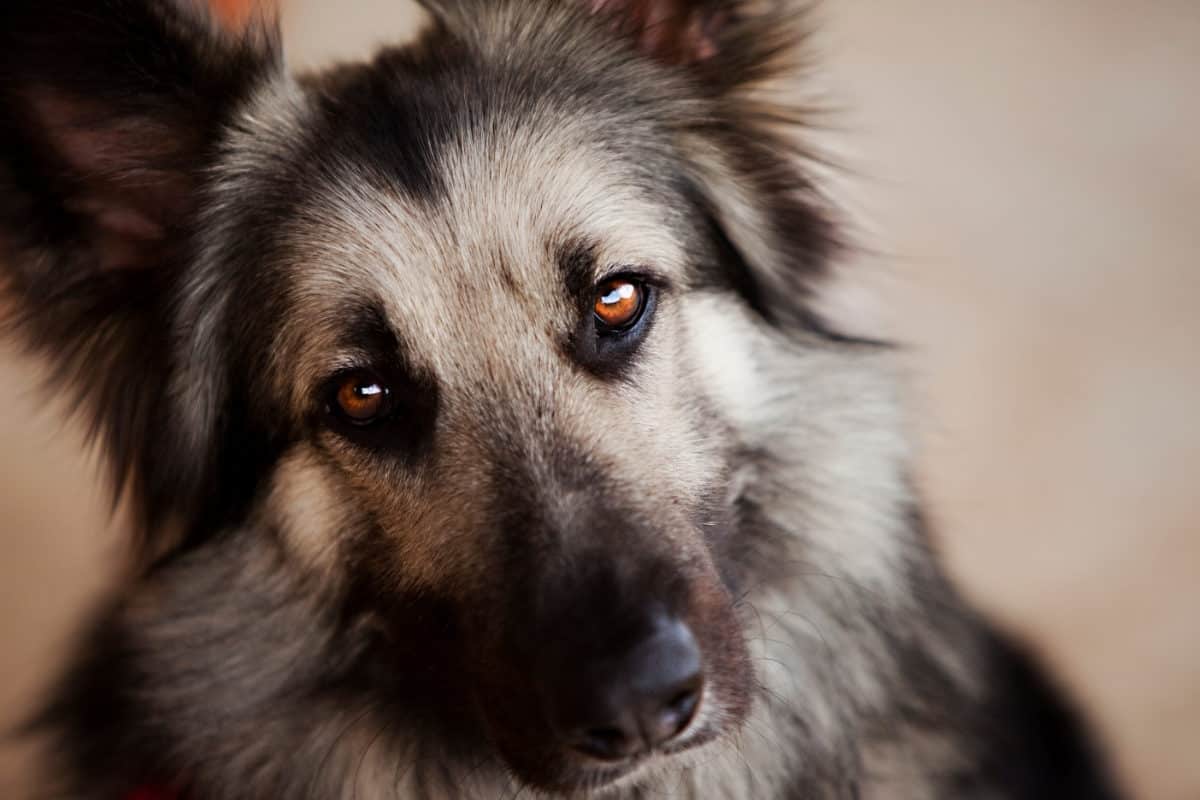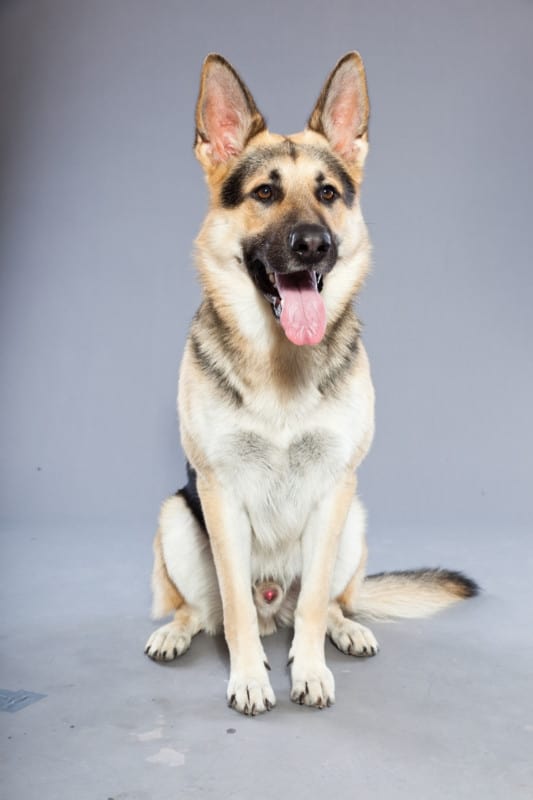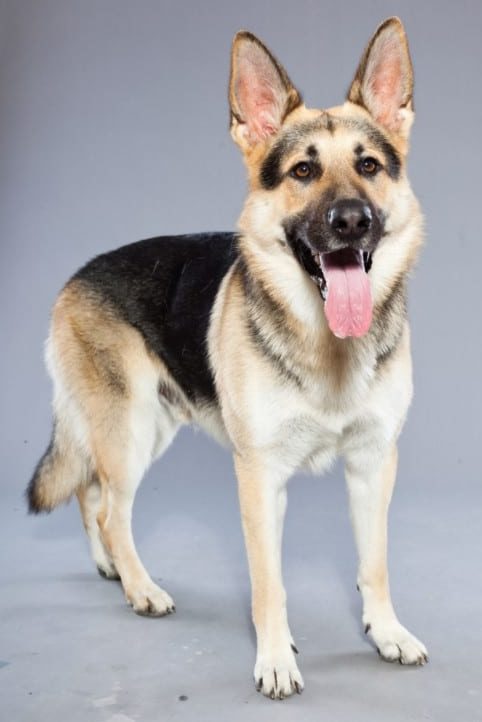If the words “Silver German Shepherd” excite you, chances are you’re about to buy one. It is only reasonable to find out more about the breed, then. So here are a few interesting facts about silver German Shepherds to get started.
- The silver German Shepherd can be traced back to 1899.
- The silver color in a GSD comes from muted black.
- A silver German Shepherd doesn’t have the canine gene responsible for silver color.
- Non-silver German Shepherds can birth a silver puppy.
- Silver GSDs are closer to the original German Shepherd.
- As far as temperament is concerned, silver German Shepherds are no different from standard GSDs.
- Silver GSDs can be shown, but their chances of winning are fewer than other varieties.
- The silver color does not affect their health.
- A silver German Shepherd can cost between $2000 and $2500.
If the above facts have piqued your interest in silver GSDs, then this article will cover everything you need to know, including the breed’s origin, health, and temperament.
We will also dispel common myths about silver GSDs so you come out with accurate information and a complete picture before deciding if a silver German Shepherd is a dog for you.

Silver German Shepherd Breed Profile
The silver German Shepherd is a variant of the German Shepherd breed with a silver coat color that distinguishes it from others and gives it a unique look.
They do not have a distinct history separate from the rest of the breed and have the same temperament and health as the standard type.
Check out the breed overview below for a quick snapshot:
| Silver German Shepherd | Breed Characteristics |
|---|---|
| AKC Group | Herding |
| Origin | Germany |
| Type | Working / Companion |
| Breed Size | Medium-large |
| Height | 24-26 inches (Males) 22-24 inches (Females) |
| Weight | 66-88 pounds (Males) 49-71 pounds (Females) |
| Temperament | Brave, Loyal, Protective, Guard-dog, Strong, Confident, Intelligent, Alert, Independent, Energetic, Aloof, Devoted, Versatile, Territorial |
| Appearance | Long Muzzle, Domed Forehead, Erect Ears, Bushy Tail, Physical Build, Well-balanced, Black Nose |
| Lifespan | 10-13 years |
| Health Issues | Bloat (GDV), Hip and Elbow Dysplasia, Von Willebrand’s disease, Degenerative Myelopathy |
| Coat Colors | Silver-grey, Black & Silver, Silver Sable, Black & Silver Sable |
| Coat Type | Short-medium, Medium, Long (Rare), Double-coated |
| Shedding | Heavy |
| Grooming | Moderate |
| Easy to Train | Yes |
| Exercise Needs | Medium-high |
| Hypoallergenic | No |
| Child Friendly | Yes |
| Pet Friendly | Yes |
| Good for new owners | Yes |
| Cost | $2000 – $2500 |
Origin and History
The Silver German Shepherd coexists with all breed variations, with a long history of being bred as the perfect herding dog. After the First World War, the breed was officially known as the “Alsatian Wolf Dog” in the UK.
In 1977, its name was changed back to German Shepherd. This correlates with anti-German sentiments that lasted throughout the war.
The ancestral origin of the silver German Shepherd is (as the name suggests) Germany, where General Max von Stephanitz spent 35 years of his life researching and breeding dogs.
In this process, he intended to develop the ideal herding dog and cross-bred different species because trying to get a better dog by breeding the same bloodline would be ineffective.
Ultimately, he did create the “perfect” dog, the German Shepherd. The different types of German Shepherds available today come from him.
The breed ranked as the 4th most registered breed in 2022 by the American Kennel Club, and they remain popular all around the globe.
Although silver German Shepherds are a subset of the mainstream GSDs, they have the same build and physique. Their breeding history is also no different from other German Shepherd dogs.
They are a relatively modern breed, with their origin dating back to 1899. Silver GSDs have a wolf-like appearance and were originally working dogs developed for herding sheep.
But because of their friendly nature, intelligence, strength, obedience, and trainability, they are now bred worldwide for other types of work, such as search and rescue, police, military roles, disability assistance, and acting roles.
Its appearance makes it stand out from other GSD dogs.
German Shepherds officially come in a wide range of colors, including black and cream, black and red, black and silver, black and tan, bicolor, all-black, blue, grey, liver, sable, and white.
Blue, grey, white, liver, and silver German Shepherds within this range are considered unique and are pretty rare as well.
However, it goes without saying that amongst the 11 listed and recognized colors, the AKC breed standard prefers strong and rich colors, which is another reason behind the silver German Shepherds’ rarity.
Washed-out colors are considered undesirable because they are seen as faults, and white is disqualified from the show ring.
Size and Appearance
Sorry to disappoint some – but silver German Shepherds are not always gray and glimmering. So, what does a silver GSD look like?
Silver German Shepherds have an off-tan coloration. Silver color can range from cream to an off-white color but comes in a metallic sheen in most cases.
Since silver is a modification of reds and tans or pheomelanin pigmentation, they usually have black areas amongst the silver portions.
Silver bi-color dogs are also predominantly black with minimum silver points and extended saddles and blankets similar to their tan counterparts. Scientists also believe their unusual coloration results from a modifier on red or tan hair.
They are also known as silver sable German Shepherds. Like all Alsatians, they have a distinctive head, domed forehead, and triangular pointy ears that stand open at the front but are often pulled during movement.
Silver German Shepherds are large dogs with a moderately long body length to height ratio.
Males weigh 66-88 lbs and are about 24-26 inches tall. Females weigh 49-71 lbs and will be 22-24 inches tall. There is no standard weight range set by the American Kennel Club official breed standard.
These dogs usually have a long muzzle, a short-medium to medium dense double coat, a soft and long plush tail reaching the hock, and a long neck that raises when excited and lowers when moving quickly.
Silver GSDs possess numerous physical qualities matching standard German Shepherds and are thus not different in build.

Dispelling the Myths – The Silver Color and Behavior
The founder of the German Shepherd breed, Max von Stephanitz, said himself, “No good dog is a bad color.” The behavior of the silver German Shepherds is not affected by their coat color.
Their silver color is simply a variation that plays no part in determining their temperament.
No German Shepherd variation possesses the G series Greying gene. So, where does the silver color come from then, genetically?
In German Shepherd coat color genetics, although clear scientific and genetic evidence explaining the silver coat color is not available, scientists have found out that they come from the A-series or the Agouti series.
This same series also produces the sable German Shepherd and contains at least one Agouti allele not paired with a dominant sable allele. The agouti becomes quite distinctive when combined with red hair dilution, which results in the red hairs becoming cream or greyish.
This gives us wolf grey or silver German Shepherds, like the Czech Wolfdogs, Saarloos Wolfhounds, Keeshond, Vallhund, or Elkhound. Studies clearly show that the silver coat color of these breeds is merely a genetic phenomenon and does not affect their temperament.
Although some can be more aloof than others, they bond quickly and powerfully with their families. However, remember that they are not friendly to every stranger they meet and need adequate socialization and training.
They are good with children and make excellent family dogs, but you need to set specific boundaries for them, just like any other breed. They often take on a guardian role for those within their family, owing to their history of herding sheep.
Silver German Shepherds do not like staying alone for long periods and can become destructive if unexercised and boredom sets in.
You can curb their behavior by giving them essential mental and physical exercise by including various activities, training, and problem-solving puzzles in their routine.
This ensures they drain excess energy by channeling it into constructive and exciting activities.
Health and the Silver Color Myths
Coat color affects the health of some breeds, but that is not the case for silver German Shepherds. Their glorious color has no bearing on their health.
They are, however, prone to certain health conditions, but that has nothing to do with their coloration. Their health correlates with that of other German Shepherd types.
Hip and elbow dysplasia are some of the most common health-related complications in this breed. Instead of looking for a relationship between health and coat color, one should look at the health condition of parent dogs.
Parents with high scores for hips and elbows should reduce the chances of puppies developing these conditions.
However, sometimes, these complications arise well past a stud’s breeding age. By then, puppies with dysplasia risk are already bred and sold. Silver German Shepherds are a relatively healthy breed.
However, like most breeds, they are prone to some conditions, such as:
- (OCD) Osteochondritis dissecans (abnormal cartilage growth)
- Bloat (GDV)
- Exocrine pancreatic insufficiency
- Degenerative myelopathy (a progressive neurologic disorder)
- Von Willebrand’s disease (a clotting disorder)
Don’t worry, though, as you can manage many of these conditions. For example, my German Shepherd has arthritis of the spine, but she is doing just fine with exercise modification and prescribed painkillers and anti-inflammatories.

FAQs
How Much Does a Silver German Shepherd Cost?
A silver German Shepherd puppy usually costs between $2000 and $2500 when bought from a reputable breeder. Their price depends on a few factors: rarity, litter size, breeder experience and qualifications, location, vet fees, and health checks.
They are more expensive than their common counterparts simply because of their color. Their unique coat coloring results from two recessive genes, one from each parent. This requires both parents to be carriers, even if they do not have a silver coat.
Not every German Shepherd carrying this recessive gene has a silver coat – it may skip a generation or two. This requirement makes the breeding process of silver German Shepherds quite tricky and expensive.
Moreover, since recessive genes do not always appear in offspring, breeders never know if the puppy will be born silver.
That’s the thing with recessive genes; even if both parents carry them, there is still only a 1 in 4 chance for the puppy to have a silver coat. Their price matches their rarity.
Other factors, such as health screening, location, etc., also affect the dog’s price. Although adopting a silver German Shepherd is more affordable than buying from a breeder, it is pretty challenging to find them in shelters. Consider yourself extremely lucky if you do!
Are Silver German Shepherds Purebred?
Silver German Shepherds are purebred and are not mixed breed. They differ only in color from other types of GSD and have the same traits, behavior, and health issues. They can only be produced when two recessive silver German Shepherds are bred.
Since the coat color depends upon a recessive gene, they cannot be produced with a mix of other breeds.
Although unusual and majestic, their color is not preferred by many and is considered a fault by the American Kennel Club because of its washed-out appearance. This adds to the difficulty in their breeding.
This is where it gets complicated (unless you’re a scientist).
Let me explain…
Their color is genetically determined as alleles responsible for coloration are influenced by different locations or loci along the dog’s chromosomes.
Each locus has a unique name assigned by scientists. Every set of genes has two copies, which may be different or identical. If they are different, one gene usually dominates the other and shows up as a physical characteristic.
The suppressed gene is called recessive and is not expressed in the phenotype. Each parent randomly passes one of their two genes to each puppy, determining their physical characteristics.
Even though recessive genes are not expressed, they can appear in later generations as recessive traits.
That is why only a silver German Shepherd puppy doesn’t need to be produced by two silver parents. Similarly, a non-silver German Shepherd possessing the recessive silver coloration gene can also have a silver puppy.
However, silver German Shepherds are always purebred despite very few breeders opting to breed them due to these breeding difficulties and high mating costs.
Can You Show a Silver German Shepherd?
Silver German Shepherds can be registered with the American Kennel Club as black and silver and have complete access to conformation exhibitions and other dog shows.
However, the AKC usually considers diluted colors a serious fault, as do judges of most shows.
German Shepherds of strong, rich colors are not only preferred by owners but are also given special consideration in dog shows. It goes without saying that rich-colored German Shepherds are encouraged by the breed standard as well.
Even though the first registered German Shepherd Dog was a sable color pattern, saturated breeds like black and tan German Shepherds have become more prominent.
You may come across a working silver sable GSD because working German Shepherds have more color variation.
Show line dogs, in comparison, have fewer variations, and thus, a show ring silver German Shepherd would be pretty rare.
There is no differentiation between black and silver German Shepherds and black and cream by the American Kennel Club, which may confuse most people.
Although quite different from black and tan pups, black and silver German Shepherd puppies do not have many objective differences from black and cream pups.
However, those with a keen eye can distinguish the two as black and silver GSDs have white with less reddish or yellowish tones than cream-colored dogs.
The AKC accepts silver as a color variation. Silver can also infiltrate sable, but such dogs would still be classified as sable by the AKC.
Do silver German Shepherds require different care?
No, silver German Shepherds do not require different care than regular German Shepherds. While their coat color is different, their needs are the same.
You will still need to give them daily exercise, regular brushing to prevent matting and high-quality nutrition.
Note: Be sure to visit the vet annually for checkups and maintain their training.
How do you distinguish a silver German Shepherd from other colors?
The silver coat is how you can distinguish this color variation. Their fur will range from a pale cream to a light grey rather than the traditional black and tan. Take a close look at their coat—silvers will lack defined coloring and appear much lighter overall.
Pay attention to the subtle tones of their fur to identify if the puppy or dog is a silver German Shepherd.





